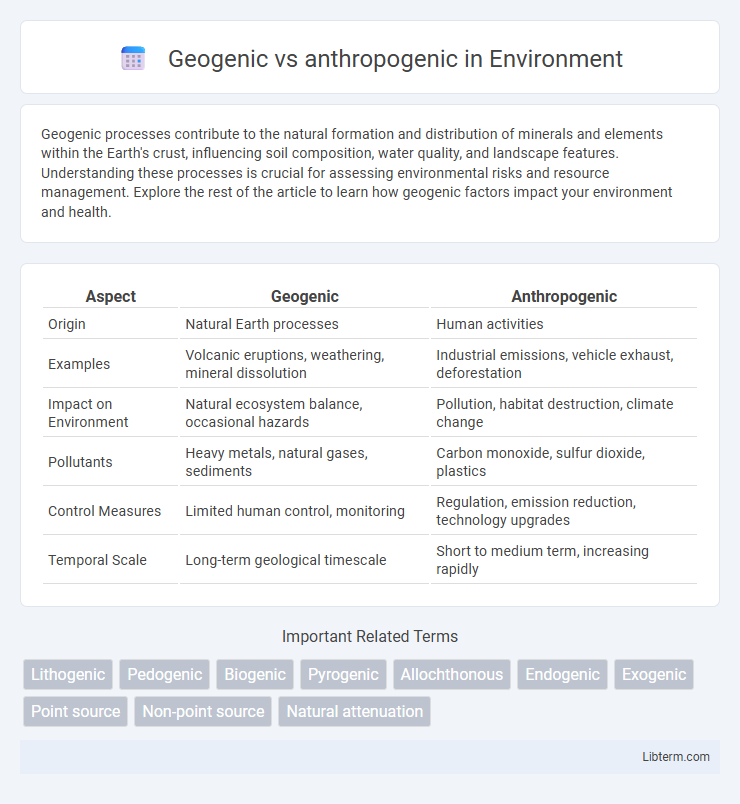Geogenic processes contribute to the natural formation and distribution of minerals and elements within the Earth's crust, influencing soil composition, water quality, and landscape features. Understanding these processes is crucial for assessing environmental risks and resource management. Explore the rest of the article to learn how geogenic factors impact your environment and health.
Table of Comparison
| Aspect | Geogenic | Anthropogenic |
|---|---|---|
| Origin | Natural Earth processes | Human activities |
| Examples | Volcanic eruptions, weathering, mineral dissolution | Industrial emissions, vehicle exhaust, deforestation |
| Impact on Environment | Natural ecosystem balance, occasional hazards | Pollution, habitat destruction, climate change |
| Pollutants | Heavy metals, natural gases, sediments | Carbon monoxide, sulfur dioxide, plastics |
| Control Measures | Limited human control, monitoring | Regulation, emission reduction, technology upgrades |
| Temporal Scale | Long-term geological timescale | Short to medium term, increasing rapidly |
Introduction to Geogenic and Anthropogenic Origins
Geogenic origins refer to natural processes such as volcanic activity, weathering of rocks, and soil formation that contribute to the presence of elements and compounds in the environment. Anthropogenic origins encompass human activities like industrial production, mining, agriculture, and urban development that introduce pollutants and alter natural chemical distributions. Distinguishing between these sources is crucial for environmental monitoring, pollution control, and resource management.
Defining Geogenic Processes
Geogenic processes refer to natural geological activities such as volcanic eruptions, weathering, and erosion that shape the Earth's surface and contribute to the formation of minerals and soils. These processes occur independently of human influence and are driven by internal Earth dynamics and external forces like climate. Understanding geogenic processes is essential for distinguishing natural environmental changes from those caused by anthropogenic activities such as industrial pollution or land-use alteration.
Defining Anthropogenic Activities
Anthropogenic activities refer to human actions that impact the environment, such as industrial manufacturing, urban development, and agriculture. These activities contribute to pollution, greenhouse gas emissions, and habitat destruction, distinguishing their effects from natural geogenic processes like volcanic eruptions or mineral weathering. Understanding anthropogenic sources is crucial for addressing environmental challenges and implementing sustainable resource management.
Key Differences Between Geogenic and Anthropogenic Sources
Geogenic sources originate from natural geological processes such as volcanic eruptions, rock weathering, and mineral dissolution, releasing elements and compounds into the environment without human intervention. Anthropogenic sources stem from human activities like industrial emissions, fossil fuel combustion, and agricultural practices, often leading to higher concentrations of pollutants such as heavy metals, greenhouse gases, and synthetic chemicals. Key differences lie in origin, with geogenic processes being naturally occurring and anthropogenic sources driven by human actions, which typically result in more localized and intensified environmental impacts.
Common Geogenic Contaminants in the Environment
Common geogenic contaminants in the environment include naturally occurring substances such as arsenic, fluoride, radon, and heavy metals like lead and mercury, which originate from the earth's crust through geological and geochemical processes. These contaminants frequently elevate in groundwater due to mineral dissolution, weathering of rocks, and volcanic activity, impacting drinking water quality and posing significant public health risks. Understanding the natural distribution and mobilization mechanisms of these geogenic contaminants is essential for developing effective water quality management and remediation strategies.
Major Anthropogenic Pollutants and Their Sources
Major anthropogenic pollutants primarily include nitrogen oxides (NOx), sulfur dioxide (SO2), particulate matter (PM), volatile organic compounds (VOCs), heavy metals like lead and mercury, and persistent organic pollutants (POPs). These contaminants originate from industrial processes, fossil fuel combustion, vehicular emissions, agricultural activities involving fertilizers and pesticides, and waste disposal practices. Urbanization and industrialization intensify the release of these pollutants, significantly impacting air, water, and soil quality compared to geogenic sources naturally present in the environment.
Environmental Impacts of Geogenic Factors
Geogenic factors such as volcanic eruptions, natural mineral weathering, and geothermal activities release significant amounts of greenhouse gases, heavy metals, and particulate matter, contributing to air and water pollution. These natural processes shape soil composition and water chemistry, sometimes leading to contamination that affects biodiversity and human health in vulnerable regions. Understanding the environmental impacts of geogenic factors aids in distinguishing natural baseline conditions from anthropogenic pollution, essential for effective environmental management and policy-making.
Human Health Risks from Geogenic and Anthropogenic Exposure
Geogenic exposure to naturally occurring elements like arsenic, radon, and fluoride poses significant human health risks, including cancer, respiratory diseases, and neurological disorders. Anthropogenic activities, such as industrial emissions, mining, and agricultural runoff, introduce heavy metals, pesticides, and synthetic chemicals into the environment, exacerbating chronic conditions and acute toxicities. Understanding the distinct pathways and toxicological profiles of geogenic versus anthropogenic contaminants is critical for effective risk assessment and public health interventions.
Strategies for Managing Geogenic and Anthropogenic Pollution
Effective management of geogenic pollution involves techniques such as natural attenuation, chemical stabilization, and source control to mitigate contaminants like heavy metals and naturally occurring radionuclides. Anthropogenic pollution requires comprehensive strategies including industrial emission reduction, wastewater treatment, and adoption of sustainable agricultural practices to limit pollutants like pesticides, heavy metals, and synthetic chemicals. Integrating advanced monitoring technologies and regulatory frameworks enhances the targeted mitigation of both geogenic and anthropogenic sources, ensuring environmental and public health protection.
Future Perspectives on Geogenic and Anthropogenic Research
Future perspectives on geogenic and anthropogenic research emphasize advanced remote sensing technologies and machine learning algorithms to improve the identification and monitoring of natural versus human-induced environmental changes. Integrating big data analytics with geospatial information systems will enhance predictive modeling of geological hazards and pollution sources, facilitating more effective mitigation strategies. Collaborative interdisciplinary approaches will drive innovation in sustainable resource management and climate change adaptation by distinguishing complex interactions between geogenic processes and anthropogenic activities.
Geogenic Infographic

 libterm.com
libterm.com